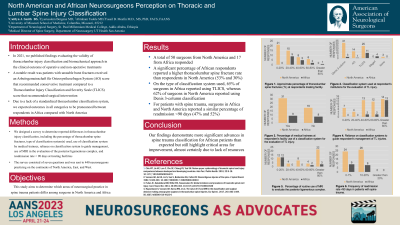North American and African Neurosurgeons Perception on Thoracic and Lumbar Spine Injury Classification
Friday, April 21, 2023

Has Audio

Caitlyn Smith, BS
Medical Student
University of Missouri School of Medicine
Columbia, Missouri, United States
ePoster Presenter(s)
Introduction: In 2021, we published findings evaluating the validity of thoracolumbar injury classification in the clinical outcome of operative and non-operative treatments. A notable result was patients with unstable burst fractures received an Arbeitsgemeinschaft für Osteosynthesefragen System (AO) score that recommended conservative treatment compared to a Thoracolumbar Injury Classification and Severity Scale (TLICS) score that recommended surgical intervention. We designed a survey to determine reported differences in thoracolumbar injury classification, including the percentage of thoracolumbar spine fractures, type of classification system(s) used, use of classification system by medical trainees, reliance on classification system to guide management, use of MRI in the evaluation of the posterior ligamentous complex, and readmission rate < 90 days at treating facilities. This study aims to determine which areas of neurosurgical practice in spine trauma patients differ among surgeons in North America and Africa. Due to a lack of a standardized thoracolumbar classification system, we expected outcomes in all categories to be pronounced between respondents in Africa compared with North America.
Methods: The survey consisted of seven questions and was sent to 440 neurosurgeons practicing on the continents of North America, East, and West.
Results: A total of 50 surgeons from North America and 17 from Africa responded. A significant percentage of African respondents reported a higher thoracolumbar spine fracture rate than respondents in North America (53% and 30%). On the type of classification system used, 65% of surgeons in Africa reported using TLICS, whereas 62% of surgeons in North America reported using Denis 3-column classification. For patients with spine trauma, surgeons in Africa and North America reported a similar percentage of readmission < 90 days (47% and 52%).
Conclusion : Our findings demonstrate more significant advances in spine trauma classification for African patients than expected but still highlight critical areas for improvement, almost certainly due to lack of resources.
Methods: The survey consisted of seven questions and was sent to 440 neurosurgeons practicing on the continents of North America, East, and West.
Results: A total of 50 surgeons from North America and 17 from Africa responded. A significant percentage of African respondents reported a higher thoracolumbar spine fracture rate than respondents in North America (53% and 30%). On the type of classification system used, 65% of surgeons in Africa reported using TLICS, whereas 62% of surgeons in North America reported using Denis 3-column classification. For patients with spine trauma, surgeons in Africa and North America reported a similar percentage of readmission < 90 days (47% and 52%).
Conclusion : Our findings demonstrate more significant advances in spine trauma classification for African patients than expected but still highlight critical areas for improvement, almost certainly due to lack of resources.
